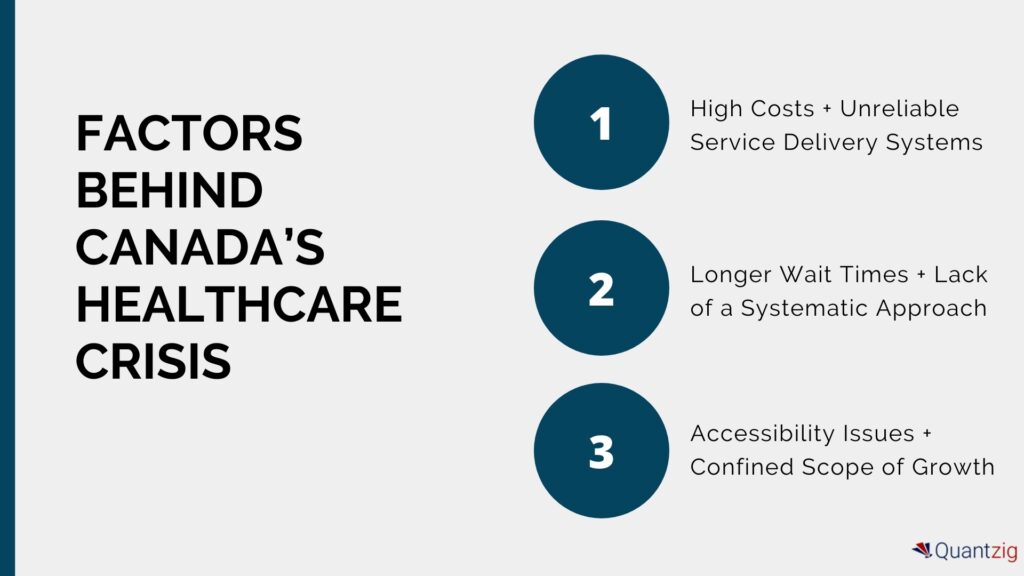Why the Canadian Health System is Not Working
Canada is known worldwide for its free healthcare, covering the most important medical care for its citizens family doctor consultations, tests and surgeries. The healthcare services in Canada are provided based on need rather than the ability to pay for them. The federal government’s roles following the Canada Health Act include:
- Providing funding to the provinces and territories to deliver healthcare services to their residents
- Provide funding and healthcare services to refugees, federal inmates, the army, First Nations and the Inuit people.
Under the Canada Health Act, the provinces and territories will also have to respect and meet the conditions laid out in that Act to be able to receive the said funding from the federal government. The provinces and territories govern and deliver the majority of healthcare services in Canada. Not all medical care services are covered. However, it is under the province’s and territory’s discretion to choose to cover additional medical care like prescription drug provision, and dental work or not. In these provinces and territories, their laws stipulate that private insurers are restricted from offering coverage that duplicates that of the publicly funded plans, but they can compete in the supplementary coverage market. Many companies include these as part of their employee benefit packages. Supplementary coverage can also be purchased from private insurance providers.

What are the pros and cons of the Canadian healthcare system?
The positives include:
- Access to healthcare for everybody
- Almost no paperwork
- No complicated bills
- Special care for special needs
- Education and preventative programs to reduce costs
Negatives:
- Priority assessment means that some patients will wait longer
- Rural areas may not be covered sufficiently, especially compared to metropolitan areas
- Lack of medical technology innovation
- Dental care and prescription drugs are mostly not covered by the provincial or territorial government

What are the issues with Canadian healthcare?
Back in July of 2022, the respective heads of the 13 provinces of Canada unanimously called upon Justine Trudeau, the Canadian prime minister to address what they referred to as the deterioration of the healthcare system. They cited the shortages of healthcare workers and the lack of coordination between the federal and provincial governments as the primary reasons for the crises plaguing healthcare in Canada. Since then, the situation is thought to have deteriorated. The global COVID-19 pandemic has aggravated the pre-existing challenges to the healthcare system of Canada. This has resulted in acute staff shortages across the country, leading to severe exhaustion and burnout among healthcare workers. This has led to increased mental health issues and a lot of resignations by these workers. These staffing and funding issues have also significantly increased the waiting time for Canadians to receive treatment in hospitals.
The median waiting time for Canadians to receive treatment at hospitals was about 27.4 weeks, up from 25.6 weeks in 2021. These issues have proven to have devastating effects on Canadians and their right to life. Patients have been known to die while waiting for medical treatments, which is shown in the increase in emergency room deaths in Nova Scotia, a 10% increase in 2022. Of the over 30 countries with universal insurance coverage, Canada ranked as the highest spender on healthcare as a share of its economy (13.3%) and 8th highest on a per-person basis (after adjusting for age). However, despite the spending, the county’s performance was middling to poor. The money spent was simply not translating to better resources and timely care. For example, Canada ranked 23rd out of 28 countries for the number of somatic care beds on an age-adjusted basis.
Canada also had fewer physicians available, ranking 28th out of 30 countries. They also had fewer MRI and CT scanners available, ranking 26th out of 29 and 27th out of 30 countries, respectively. While some Canadians hope that the government can spend their way out of these issues. As it has been shown that Canada is already the one of the most expensive healthcare systems in the world, new methods of addressing the pending issues must be discovered and explored.
What is the way forward?
There have been some short and long-term recommendations to the Canadian House of Commons to revive Canada’s failing healthcare system. The primary recommendation suggested a framework in the form of a “Pan-Canadian Health Human Resource” to improve the coordination between the federal, provincial and territorial governments. The federal government provides the funding and sets the national standards, leaving the provincial and territorial governments responsible for the management and delivery of healthcare. Thus, there have been increased calls for the federal government to become more involved in the delivery of healthcare services.
The suggestions also offer multi-fold directions to resolve the healthcare staffing shortages. They recognized the need to recruit internationally trained healthcare workers and suggested streamlining and simplifying the process to recruit these workers, including providing more residency positions for internationally trained medical graduates. There has also been the opinion of experts that there is a need for a “pan-national licensure” which will allow doctors to practice across Canada with much fewer regulations.
Currently, each Canadian province has its own set of regulations, which act as a barrier for doctors willing to practice outside their provinces. Also, to support the overburdened health workers, a Pan-Canadian mental health strategy should be adopted to improve their mental wellness. And lastly, there is also a need for a Pan-Canadian health data strategy to help facilitate the improved collection and sharing of workforce data in the healthcare sector. This will allow for the making of well-informed policy decisions in the future by the Canadian government. This is because, in the instance of shortages, the Canadian government cannot adequately plan for the supply needs without properly collecting the data on demographics, previous activity and the practice location. The Canadian government in addressing these health crisis issues has taken a much-welcomed first step in making bilateral funding commitments in their federal budget for 2023-2024.
The information provided in this blog is for educational purposes only and should not be considered as medical advice. It is not intended to replace professional medical consultation, diagnosis, or treatment. Always consult with a qualified healthcare provider before making any decisions regarding your health. Read more







